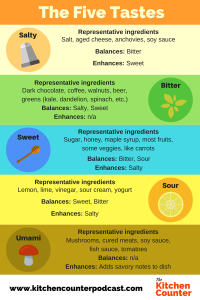Understanding how ingredients and their tastes interact with one another is a crucial step to elevating your home cooking game. In this “Introduction to the Five Tastes” I cover the five basic tastes in cooking, how they interact with one another, and how understanding this can help you be a better improviser in the kitchen.
Listen to the full episode in the player below:
Introduction to the Five Tastes
So what are the “five tastes” anyway? Well let me start by saying that this is still a somewhat inexact science, but in general there are five tastes recognized in current culinary circles. The five tastes are: salty, bitter, sweet, sour, and umami. I’ll explain each of these in a little more detail below. After I’ll talk about how to use this information in your cooking. Be sure to listen to the episode for all the details!
One note about terminology below. When I talk about a taste “balancing” other tastes, I mean it reduces the impact of the other taste, perhaps muting it a bit. When I say a taste “enhances” other tastes, I mean it makes the other taste more pronounced. For example if your salad is too bitter (e.g. full of bitter greens), try adding something salty and/or sour to balance out the bitterness and make it more palatable. The listed representative ingredients are obviously not exhaustive, but just a short sample list to give you an idea of where to look.
Salty
Salty tastes are exactly what they sound like, salty! Salty tastes balance out bitter tastes and enhances sweet tastes.
Representative ingredients in salty group include various salts, of course, along with some aged cheeses (think salty Parmesan), anchovies or anchovy paste.
Want to understand what salty tastes like? Just put a tiny pinch of salt in your mouth and you’ll get it right away.
Bitter
Humans generally don’t like bitter things. Probably because bitterness denotes some degree of toxicity in the plant world. It’s the one taste that requires some degree of “acquired taste.” Bitter ingredients aren’t really used to enhance other but they can balance out salty and sweet flavors.
Representative ingredients cover a wide variety and include dark chocolate, bitter greens (think kale, chard, spinach), coffee, beer, walnuts, and citrus peels.
Remember the first time you tried black coffee? That was bitterness. If you need a refresher, and are feeling brave, break off a dandelion stem and touch it to your tongue. It’s one of the harshest bitter tastes I know. You’ve been warned. If you aren’t that brave just munch on some raw kale.
Sweet
Sweet is the taste most naturally beloved by humans. It’s also the taste that represents the largest portion of our diets. Sweet can do wonders to balance out sour and bitter tastes, and is a natural complement to salty.
Representative sweet ingredients include sugar, honey, maple syrup, most fruits and some veggies (e.g. carrots and corn).
Sweet really needs no introduction, but a teaspoon of sugar or honey will hit the note perfectly
Sour
Sour is often confused with bitter, but the two are very different. Think of sour as that zing that makes your lips pucker and causes you to shout “wowee!” Think of bitter as that punch in the mouth that makes you grimace and groan out a “blech.”
Representative sour ingredients include lemon and lime juice, most vinegars, and many fermented dairy products like yogurt and sour cream.
A little bit of lemon juice or white vinegar will give you a nice shot of sour to reacquaint your palate.
Umami
That brings us to umami. The newest of the recognized tastes, umami is something of an earthy, meaty, savory taste. It’s often associated with salty. In fact many salty ingredients could easily be considered part of the umami group as well. Umami doesn’t really balance out other tastes as much as it can enhance an entire dish by providing some savory notes, or giving your dish som “bottom,” if that makes sense.
Representative umami ingredients include mushrooms, soy sauce, fish sauce, cured meats, and aged cheeses.
Umami is sometimes difficult to pinpoint (unlike sour for example, which can be easily demonstrated by a sip of lemon juice). To give yourself an idea of umami try some bacon, or extra aged white cheddar cheese, or a good earthy mushroom like a cremini.
How to use the five tastes in cooking
The science around the five tastes isn’t exact, and different cooks have different tolerances and enjoyment levels of the five tastes. In general though, here are the rules of thumb when it comes to adjusting tastes and flavors in recipes and finished dishes.
If your dish is too salty, try adding sweet ingredients to balance it. If you dish is just way oversalted, you may need to increase the volume of other ingredients in general to dilute the salt content overall.
If your dish is too bitter, try adding salty or sweet ingredients, or combinations thereof, to bring your dish back into balance.
If your dish is too sweet, try adding sour. Don’t add salty ingredients as it will actually make your dish taste sweeter (remember salt enhances sweet, not balance it).
If your dish is too sour, try adding some sweetness to the recipe.
If your dish seems ok and in balance, but is just missing a little something special, then it may be time to drop in some umami flavor.
I made you a handy graphic to nicely summarize the five tastes
Download and enjoy!
Connect with The Kitchen Counter Podcast!
Facebook: https://www.facebook.com/kitchencounterpodcast
Twitter: @TKCpodcast
Email: feedback@kitchencounterpodcast.com
If you liked what you heard, please consider subscribing in iTunes or in the Google Play Music store. You can also help out the show by leaving a positive review wherever you find your favorite podcasts (you know you want to)!





